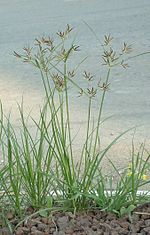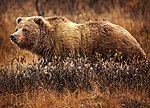Cyperus rotundus (redirect from Purple nut-sedge)
Java grass, nut grass, purple nut sedge or purple nutsedge, red nut sedge, Khmer kravanh chruk) is a species of sedge (Cyperaceae) native to Africa, southern...
22 KB (2,367 words) - 18:11, 17 August 2024
Carex chordorrhiza (redirect from String Sedge)
Carex chordorrhiza, commonly called creeping sedge or string sedge, is a species of perennial plant in the family Cyperaceae with Holarctic distribution...
5 KB (454 words) - 10:56, 15 June 2023
tundra, and Antarctic tundra. Tundra vegetation is composed of dwarf shrubs, sedges, grasses, mosses, and lichens. Scattered trees grow in some tundra regions...
29 KB (2,860 words) - 02:37, 2 September 2024
Cyperus distans, also known as slender cyperus, is a species of sedge native to tropical and subtropical wetlands in sub-Saharan Africa, Asia (India,...
2 KB (163 words) - 11:56, 17 September 2023
habitats in the Southern Arctic is the same: sprawling shrublands, wet sedge meadows, and cold, clear lakes. Superimposed on this pattern are the fascinating...
49 KB (4,990 words) - 00:48, 3 December 2023
bite through them. In spring, winter-provided carrion, grasses, shoots, sedges, moss and forbs are the dietary mainstays for brown bears internationally...
130 KB (14,624 words) - 16:08, 1 September 2024
generally improving the nutritional value of foods. Tigernut oil (or nut-sedge oil) is pressed from the tuber of Cyperus esculentus. It has properties...
103 KB (10,294 words) - 07:07, 15 August 2024
Adrian; Clay, Keith (1988). "Experimental Infection of Host Grasses and Sedges with Atkinsonella hypoxylon and Balansia cyperi (Balansiae, Clavicipitaceae)"...
19 KB (2,150 words) - 15:47, 17 July 2024
200 lb). Grizzlies in Alaska supplement their diet of salmon and clams with sedge grass and berries. In areas where salmon are forced to leap waterfalls,...
120 KB (12,596 words) - 02:00, 1 September 2024
may be an adaptation to camouflage them in moorland with higher grass and sedge content and less heather. It is identified by its 'chut!chut!chut!chut!chut...
15 KB (1,964 words) - 03:46, 2 September 2024
Moose prefer sub-alpine shrublands in early winter, while bison prefer wet sedge valley meadowlands in early winter. In late winter, moose prefer river valleys...
138 KB (14,648 words) - 02:50, 22 August 2024
material in emergent vegetation, such as hard stem bulrush, cattails and sedges, over or near standing water. Redheads do not defend their territory or...
19 KB (2,151 words) - 17:44, 1 September 2024
of predominantly C4 plants, such as low quality and abrasive grasses and sedges. Thick enamel is consistent with grinding abrasive foods. The microwear...
59 KB (7,163 words) - 21:58, 28 August 2024
the most important family of monocotyledons. Often mistaken for grasses, sedges are also monocots. In agriculture the majority of the biomass produced comes...
115 KB (11,098 words) - 16:43, 22 August 2024
food and protection. In some cases, the males provide all of them (e.g. sedge warblers). The females dwell in their chosen males' territories for access...
107 KB (13,874 words) - 20:20, 5 February 2024
from 28S rRNA sequences (Lepidoptera, Noctuoidea, Notodontidae). Tinea 23, suppl. 1: 1-83 "Family Notodontidae" at Insecta.pro azalea caterpillar, Datana...
8 KB (942 words) - 12:59, 8 November 2023
text by Poiret is earlier than that of Roemer and Schultes. It is a tufted sedge growing in clumps of up to 0.2 m and flowers from July to December or January...
2 KB (242 words) - 21:58, 27 March 2024
terrain surrounding the lake. Other plant communities in the area include wet sedge tundra, as well drier heath tundra found at higher elevations. Low growing...
15 KB (1,382 words) - 20:03, 7 November 2023
around the base of the stem. Corms can be found in irises, taro, arrowheads, sedges, and bananas; these include: Iridaceae, Araceae, Alismataceae, Asparagaceae...
27 KB (3,139 words) - 11:50, 5 April 2024
live in the high-altitude environment. These include perennial grasses, sedges, forbs, cushion plants, mosses, and lichens. High-altitude plants must adapt...
52 KB (5,493 words) - 19:57, 3 August 2024
from 28S rRNA sequences (Lepidoptera, Noctuoidea, Notodontidae). Tinea 23, suppl. 1: 1-83 Fibiger, Michael (2007). "Revision of the Micronoctuidae (Lepidoptera:...
19 KB (1,737 words) - 17:38, 23 June 2024
[nomen dubium] Motacilla modularis – dunnock Motacilla schoenobaenus – sedge warbler Motacilla campestris – orangequit Motacilla curruca – lesser whitethroat...
99 KB (6,052 words) - 09:45, 22 August 2024
South African ecosystem, grazing was found to cause a reduction of grasses, sedges, and tree species and an increase in non-succulent shrubs. Mining stream...
36 KB (4,172 words) - 11:09, 3 February 2024
Faunal regions and the diversity of Lepidoptera. Tropical Lepidoptera, 2 (Suppl. 1): 1–85. Heppner, J. (1997). Wockia asperipunctella in North America (Lepidoptera:...
12 KB (1,118 words) - 23:28, 17 August 2023























